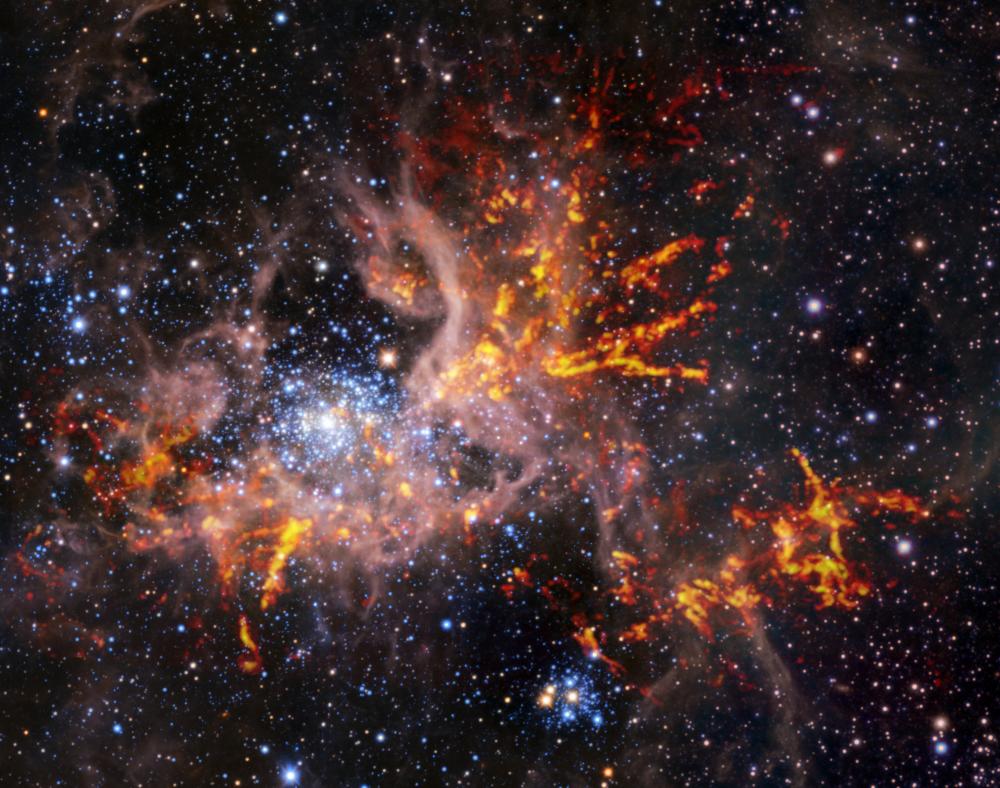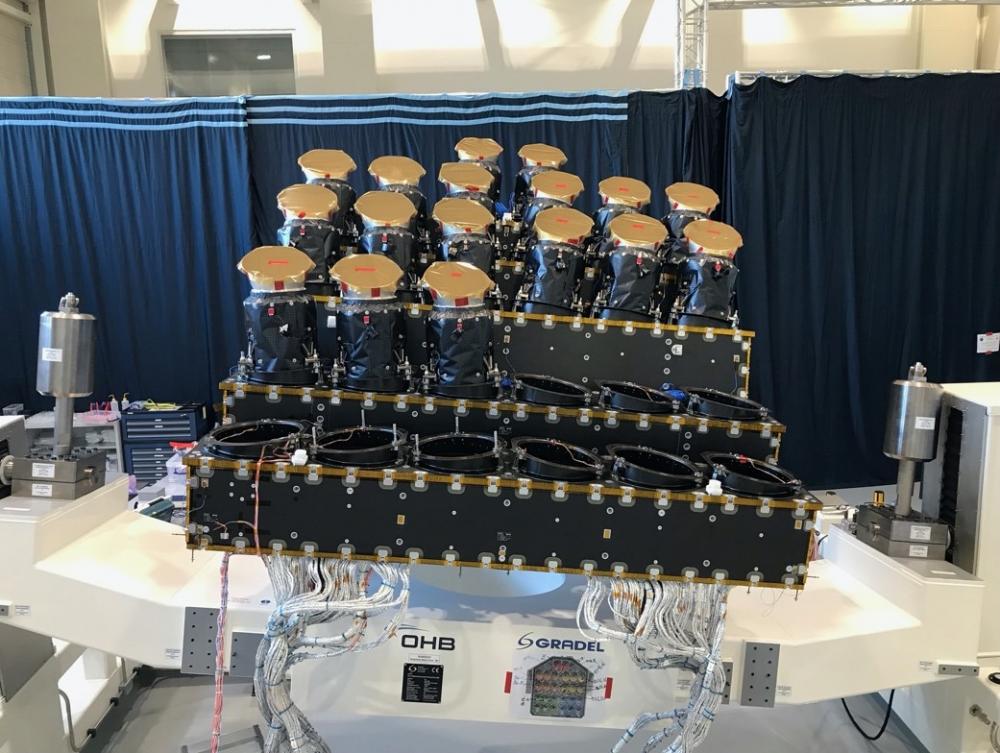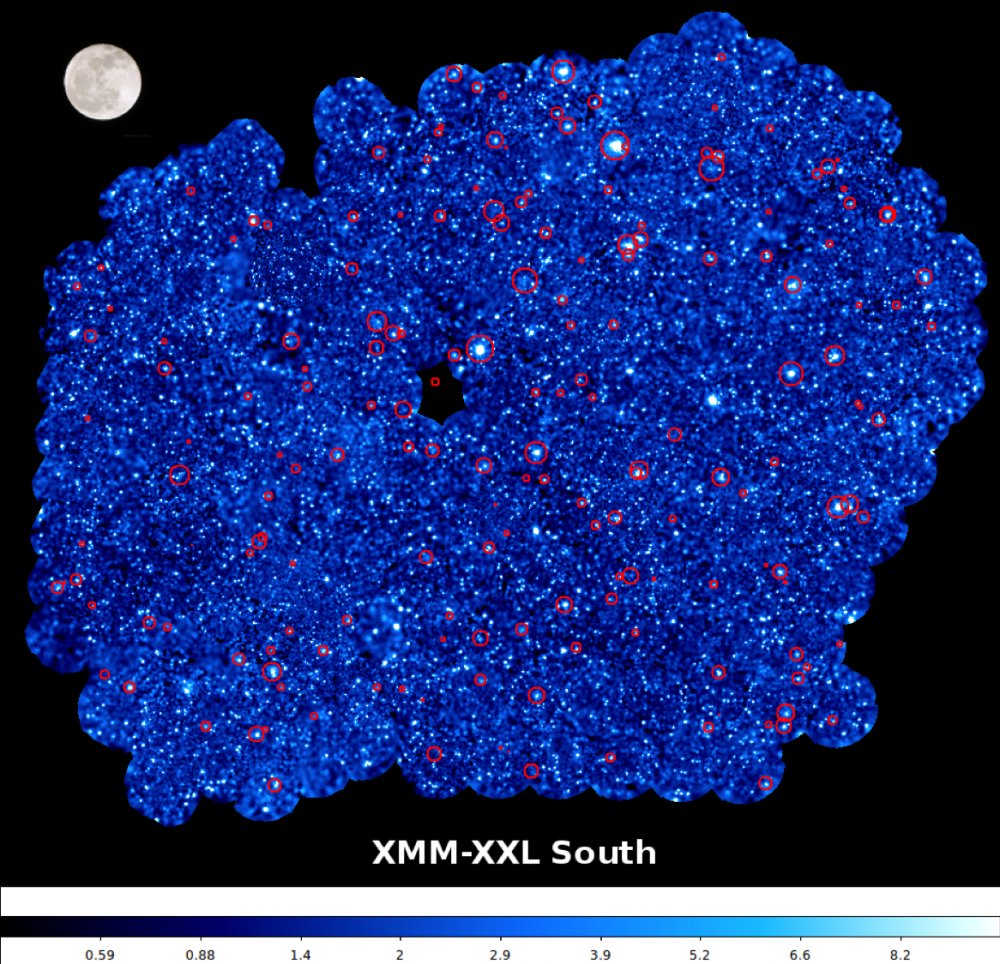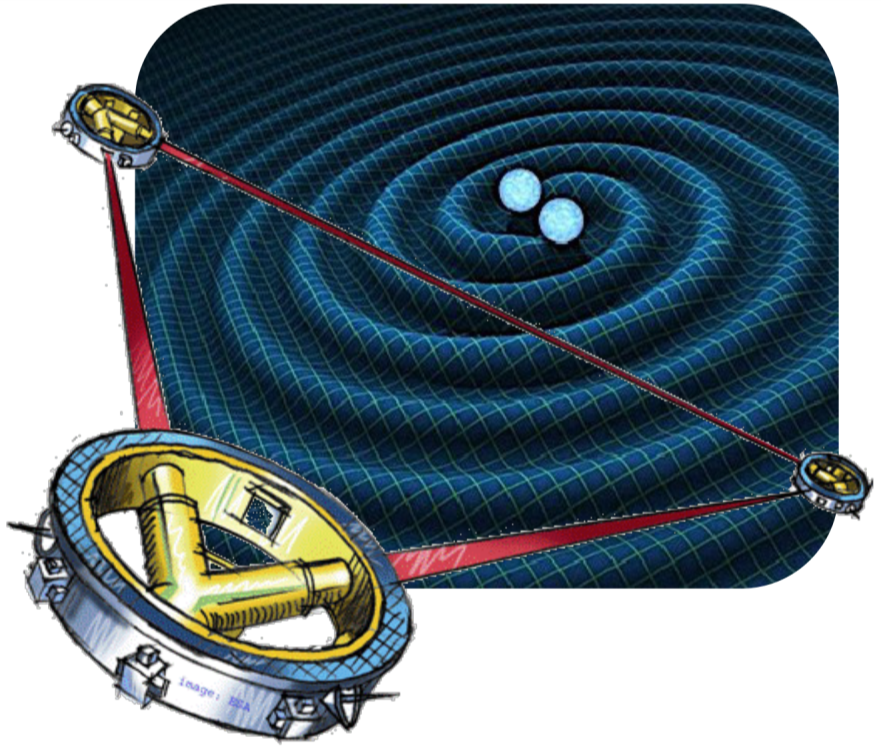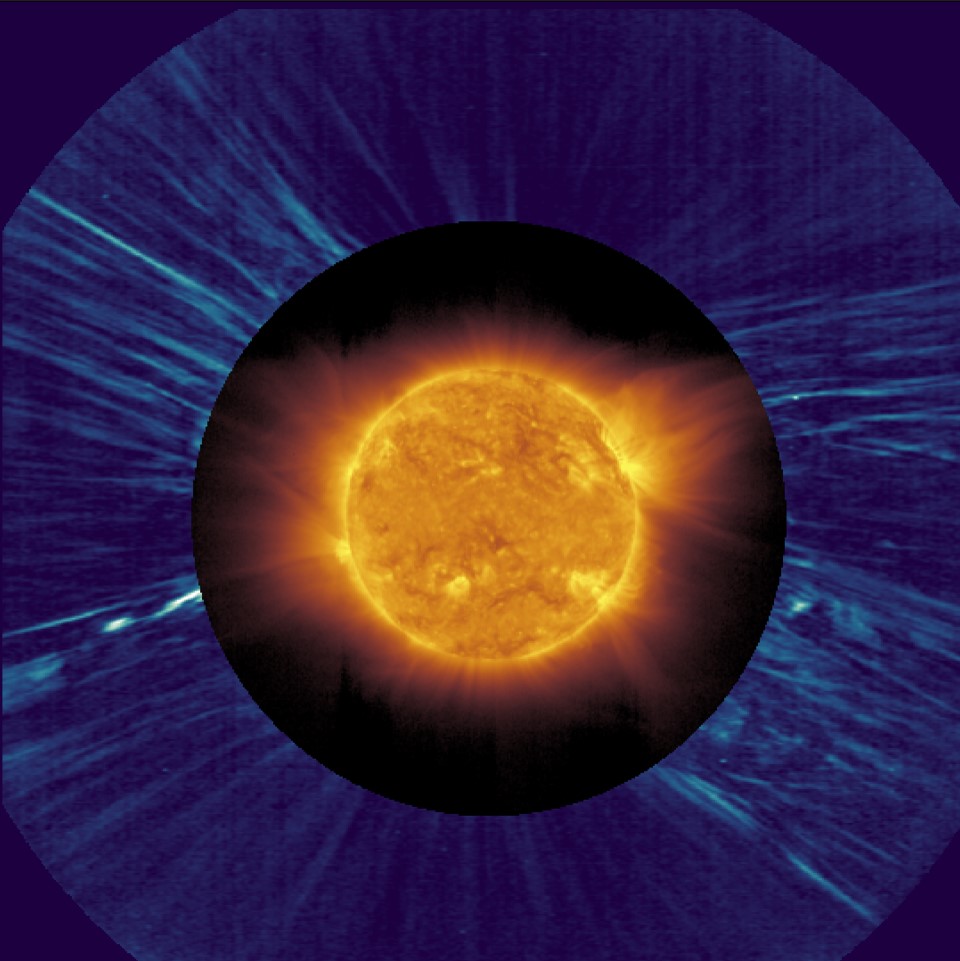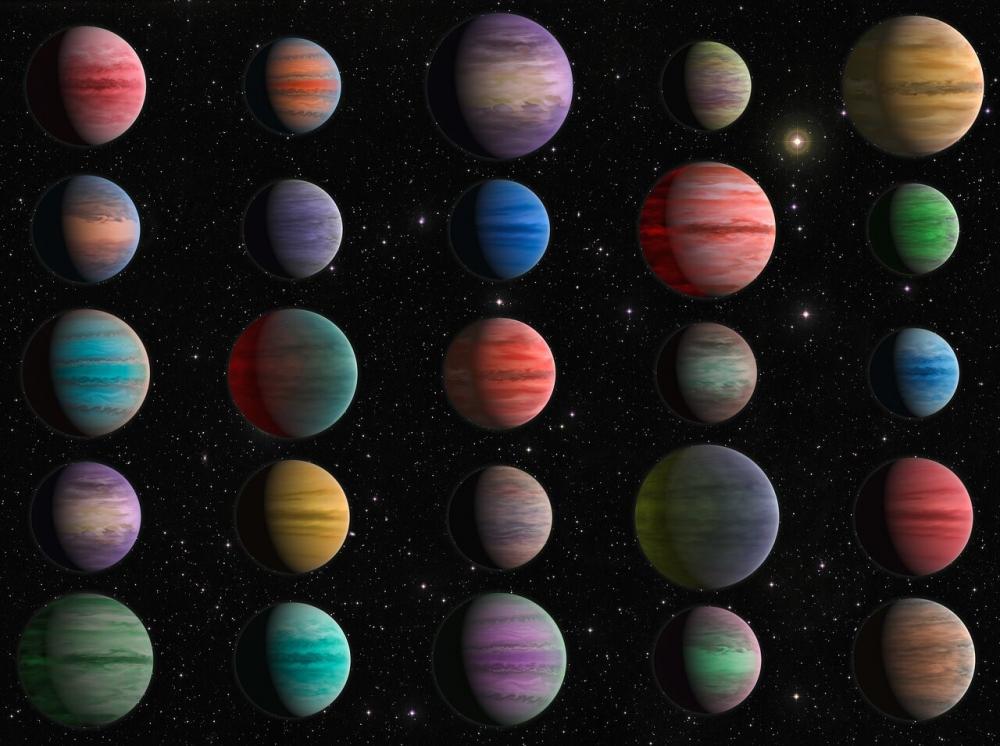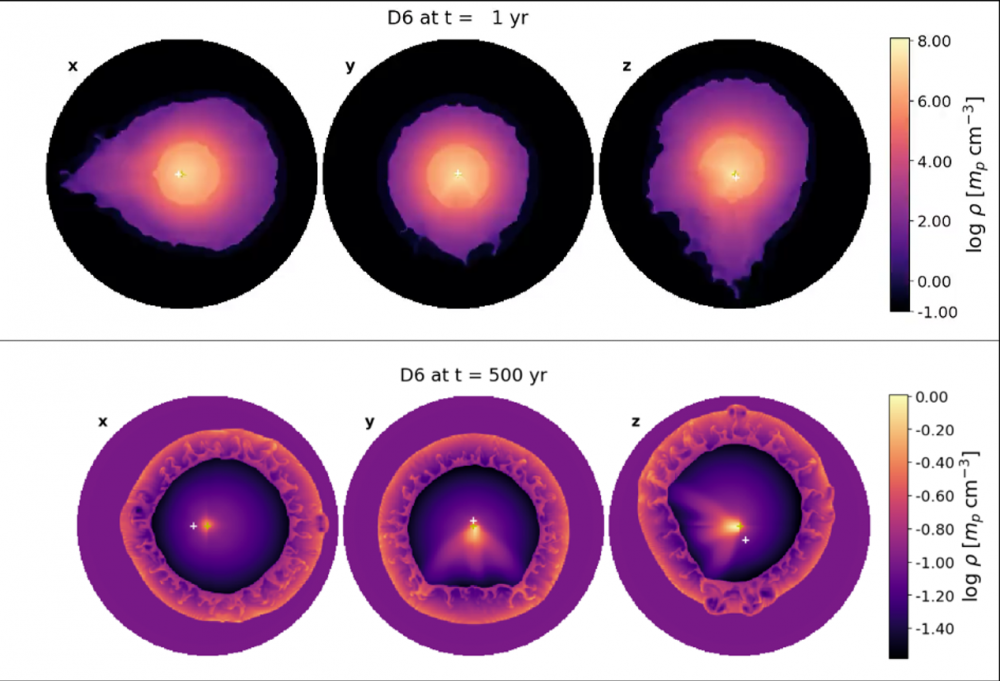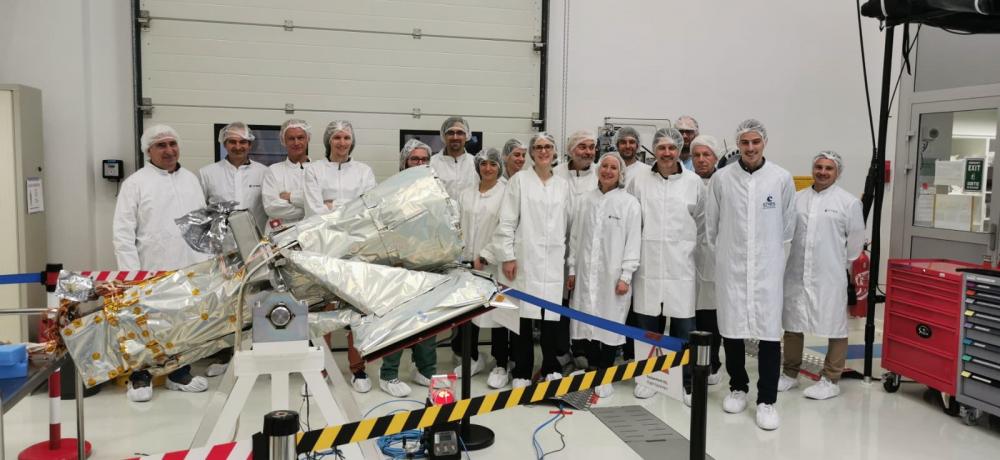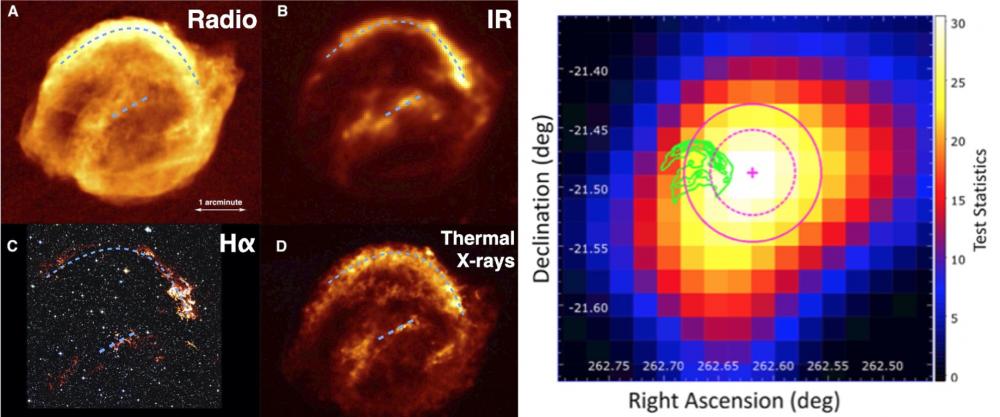News 2022
The origin of Galactic cosmic rays, their energy source and their acceleration process raise many questions more than 100 years after their discovery by Victor Hess in 1912. What are their sources of acceleration and energy? What are the acceleration mechanisms and their properties?
If these are not the only sources considered, strong shocks in supernova remnants constitute one of the privileged places of acceleration which allows the acceleration of particles by the mechanism of diffusive acceleration. Moreover, if a fraction of 10-20% of the shock kinetic energy is tapped to accelerate the particles, the supernova rate in our Galaxy can account for the energy required to maintain the Galactic cosmic ray population.
X-ray observations, on the other hand, have the advantage of being able to finely map the acceleration locations. And, of major interest, they provide information on the properties of both the thermal plasma heated to millions of degrees and the non-thermal plasma of electrons accelerated to very high energies of the order of teraelectron volts. They thus offer keys to the understanding of shock acceleration mechanisms, and specifically of their feedback and their dependence on the magnetic field.
Understanding the star formation process is a major open question in contemporary astrophysics. It is indeed the process that controls the evolution of galaxies since their birth, gradually transforming their interstellar gas into stars and enriching it with heavy elements and dust grains. It is also the formation of stars that is at the origin of the formation of planetary systems and the appearance of life. This process is however complex and still very poorly understood. It involves the understanding of a series of hydrodynamic instabilities leading to the collapse of a molecular cloud, in which gravity, magnetic field and chemistry play a central role. Moreover, the feedback, i.e. the ionizing radiation and the wind from newly formed massive stars, has the effect of destroying the rest of the molecular cloud and thus inhibiting star formation after a few million years. This feedback is a key element, but it is still insufficiently understood.
ESA's PLATO mission has been given the green light to continue its development after a successful critical review on January 11, 2022.
PLATO, or PLANetary Transits and Oscillations of stars, is the third medium-class mission in ESA's Cosmic Vision program. Its objective is to find and study a large number of planetary systems, with a focus on the properties of Earth-like planets in the habitable zone around solar-type stars. PLATO has also been designed to study stellar oscillations through asteroseismology, which will allow precise measurement of the parameters of the planets' host stars, including their age.
The review verified the maturity of the entire space segment (the service module and the payload module), confirming the robustness of the satellite-payload interfaces and the payload development schedule. Particular emphasis was placed on the serial production of the 26 cameras, and the robustness of the development schedule for both modules. PLATO will use the 26 cameras to discover and characterize exoplanets orbiting stars similar to our Sun.
For the first time since the XMM launch (1999), a cosmological analysis constraining the density of matter in the universe, from a catalog of 178 galaxy clusters detected by XMM, has been possible and in an autonomous way, i.e. with its own distance measurements and without calling upon additional information from numerical simulations or other cluster samples. This analysis was conducted in the framework of the XXL consortium, mainly by Christian Garrel during his thesis at the Astrophysics Department (DAP) of CEA Paris-Saclay (see the article on arXiv).. The results confirm the standard cosmological model in a completely independent way, with an accuracy rivalling with other probes covering much larger portions of the sky. The existing "cosmological" tension between the cosmological analyses of the clusters and the CMB PLANCK is thus lifted; there is no longer any need to use massive neutrinos.
This cosmological analysis from clusters has been possible thanks to the new method ASpiX, developed at DAP allowing to model properly the distant clusters. In the distant Universe, we only detect massive clusters, thus blue, which appear red because of the expansion of the Universe. Mathematically, the software analyses all possible combinations of the effect of cosmology on the properties of clusters.
The cosmological analysis exploiting all the observations of the XXL program is in progress and will include about 300 clusters. The novelty is that it will combine the ASpiX method with artificial intelligence techniques that allow identifying very quickly the cosmological model that best reflects the observed properties of the cluster population.
Scientists from the CosmoStat laboratory at CEA have produced within the international science collaboration UNIONS (Ultraviolet Near Infrared Optical Northern Survey) a reference catalogue of 100 million gravitationally lensed distant galaxies, one of the largest datasets ever created. This new collection is based on thousands of deep images of the northern sky captured by MegaCam, a large digital camera built at CEA, mounted on the Canada-France-Hawaii Telescope (CFHT). Three new publications present dark-matter mass maps of the cosmic web, showing how the high-density regions in these maps help measure the still poorly known properties of dark matter. In the near future these observations will provide essential support to the European space telescope Euclid. This ESA satellite mission will map the cosmic web over the entire accessible sky at an unprecedented resolution to measure the properties of the mysterious dark energy.
The four principal investigators receive almost 10 million euros for their project 4D-STAR, which will develop and deliver innovative numerical models of rotating magnetic stars in three spatial dimensions throughout their evolution.
ERC Synergy Grants of the EU's research and innovation programme Horizon Europe, help groups of two to four outstanding researchers bringing together complementary skills, knowledge and resources in one ambitious overarching project, addressing some of the world’s most formidable research problems. The projects typically span multiple scientific disciplines - in the case of 4D-STAR astronomy, theoretical physics, fluid mechanics, applied mathematics, computer science and software development.
The LISA (Laser Interferometer Space Antenna) space mission by ESA and NASA, will observe gravitational waves from space. After its launch around 2035, LISA will observe in the low frequency band of the gravitational waves spectra and will capture the signal coming from sources which are not detected yet in the high frequency band of ground-based detectors such like Virgo, LIGO, KAGRA, or GEO600. Among the new sources of gravitational waves, the most represented are the galactic binaries whose number of detections should amount several tens of thousands. The galactic binaries are double systems made of compact stars such like neutron stars or white dwarfs in different combinations. Within the low frequency band, galactic binaries are detected during inspiral, that is to say several thousand years before fusion which is detected by ground-based detectors. Therefore, the signature of effects due to structure or internal dynamics of compact stars on the gravitational waves can potentially be detected over the lifetime of the space mission. LISA will allow to understand the state of matter inside compact objects within binary systems, their deformability, or their magnetic fields through the secular evolution of the orbits. In a recent study published in Physical Review D (DOI: https://doi.org/10.1103/PhysRevD.105.124042), a team from SYRTE in Observatoire de Paris and LDE3 from DAP/IRFU at CEA, demonstrated that the effect of magnetism within galactic binary could be measured by LISA.
As part of the Solar Orbiter science support activities and in conjunction with the ERC Synergy WholeSun grant, researchers from CEA Paris-Saclay, together with an international collaboration, have developed advanced numerical simulations to study the formation of structures of the solar wind. These simulations allow studying the interaction of the convection at the solar surface with the magnetic field. They reveal the appearance of twisted magnetic structures that can participate in the creation of switchbacks.
Understanding the star formation process is a major open question in contemporary astrophysics. It is indeed the process that controls the evolution of galaxies since their birth, gradually transforming their interstellar gas into stars and enriching it with heavy elements and dust grains. It is also the formation of stars that is at the origin of the formation of planetary systems and the appearance of life. This process is however complex and still very poorly understood. It involves the understanding of a series of hydrodynamic instabilities leading to the collapse of a molecular cloud, in which gravity, magnetic field and chemistry play a central role. Moreover, the feedback, i.e. the ionizing radiation and the wind from newly formed massive stars, has the effect of destroying the rest of the molecular cloud and thus inhibiting star formation after a few million years. This feedback is a key element, but it is still insufficiently understood.
On the evening of the 28th, we could read on NASA's blog: "It's official, the alignment of NASA's James Webb Space Telescope is now complete"!
To say that all the instruments of the James Webb Space Telescope are perfectly aligned, means that the primary mirror is well adjusted. The images are already breathtaking while the adjustment phase of all the elements of the telescope is not finished yet.
For this test, the Webb telescope pointed at a star and the quality of the alignment was verified with a part of the Large Magellanic Cloud providing a dense field of hundreds of thousands of stars on all instrument sensors. Webb's three imaging instruments are NIRCam (images below at 2 microns wavelength), NIRISS (image at 1.5 microns) and MIRI (image at 7.7 microns). MIRI detects light in a lower energy range (or longer wavelength) than the other instruments, revealing the emission from interstellar clouds as well as starlight.
These images are used to assess image sharpness, but also to accurately measure and calibrate subtle image distortions and alignments between the instrument's sensors as part of the overall Webb instrument calibration process.
Archival observations of 25 hot Jupiters by the NASA/ESA Hubble Space Telescope have been analysed by an international team of astronomers, enabling them to answer five open questions important to our understanding of exoplanet atmospheres. Amongst other findings, the team found that the presence of metal oxides and hydrides in the hottest exoplanet atmospheres was clearly correlated with the atmospheres' being thermally inverted.
Read the science release : Hubble observations used to answer key exoplanet questions | ESA/Hubble (esahubble.org)
The Solar Orbiter mission, launched on February 10, 2020 from Cape Canaveral has already traveled more than 2 billion km. Since its passage just 470 km above the Earth in November 2021, the science mission has officially begun. On March 26, 2022, Solar Orbiter passed within 0.32 astronomical units of our star (about 1/3 the distance from Earth to the Sun) for its fourth perihelion (the point in its orbit where Solar Orbiter is closest to the Sun) at a speed of 198,000 km/h. On this occasion, all 10 instruments onboard will be jointly switched on and pointing towards our star. As the cycle 25 of magnetic activity of the Sun is in full rise of intensity, it is highly probable that many eruptive events will be observed with the STIX telescope (Spectrometer Telescope for Imaging X-rays) whose detectors, the Caliste-SO, were conceived, realized and qualified at CEA.
On the occasion of this 4th perihelion, this milestone delivers one of the first X-ray images from STIX as well as new simulations of the Solar model from a DAp team, which have given rise to recent articles (see end of page)
ESA's PLATO mission has been given the green light to continue its development after a successful critical review on January 11, 2022.
PLATO, or PLANetary Transits and Oscillations of stars, is the third medium-class mission in ESA's Cosmic Vision program. Its objective is to find and study a large number of planetary systems, with a focus on the properties of Earth-like planets in the habitable zone around solar-type stars. PLATO has also been designed to study stellar oscillations through asteroseismology, which will allow precise measurement of the parameters of the planets' host stars, including their age.
The review verified the maturity of the entire space segment (the service module and the payload module), confirming the robustness of the satellite-payload interfaces and the payload development schedule. Particular emphasis was placed on the serial production of the 26 cameras, and the robustness of the development schedule for both modules. PLATO will use the 26 cameras to discover and characterize exoplanets orbiting stars similar to our Sun.
For the first time since the XMM launch (1999), a cosmological analysis constraining the density of matter in the universe, from a catalog of 178 galaxy clusters detected by XMM, has been possible and in an autonomous way, i.e. with its own distance measurements and without calling upon additional information from numerical simulations or other cluster samples. This analysis was conducted in the framework of the XXL consortium, mainly by Christian Garrel during his thesis at the Astrophysics Department (DAP) of CEA Paris-Saclay (see the article on arXiv).. The results confirm the standard cosmological model in a completely independent way, with an accuracy rivalling with other probes covering much larger portions of the sky. The existing "cosmological" tension between the cosmological analyses of the clusters and the CMB PLANCK is thus lifted; there is no longer any need to use massive neutrinos.
This cosmological analysis from clusters has been possible thanks to the new method ASpiX, developed at DAP allowing to model properly the distant clusters. In the distant Universe, we only detect massive clusters, thus blue, which appear red because of the expansion of the Universe. Mathematically, the software analyses all possible combinations of the effect of cosmology on the properties of clusters.
The cosmological analysis exploiting all the observations of the XXL program is in progress and will include about 300 clusters. The novelty is that it will combine the ASpiX method with artificial intelligence techniques that allow identifying very quickly the cosmological model that best reflects the observed properties of the cluster population.
Scientists from the CosmoStat laboratory at CEA have produced within the international science collaboration UNIONS (Ultraviolet Near Infrared Optical Northern Survey) a reference catalogue of 100 million gravitationally lensed distant galaxies, one of the largest datasets ever created. This new collection is based on thousands of deep images of the northern sky captured by MegaCam, a large digital camera built at CEA, mounted on the Canada-France-Hawaii Telescope (CFHT). Three new publications present dark-matter mass maps of the cosmic web, showing how the high-density regions in these maps help measure the still poorly known properties of dark matter. In the near future these observations will provide essential support to the European space telescope Euclid. This ESA satellite mission will map the cosmic web over the entire accessible sky at an unprecedented resolution to measure the properties of the mysterious dark energy.
While type Ia supernovae are considered as highly symmetric supernovae, the explosion in a tight binary system composed of two white dwarfs revises this paradigm. An international team (Japan, Canada, France), including a researcher from the Department of Astrophysics/AIM Laboratory of CEA Paris-Saclay, publishes a study in the Astrophysical Journal that reveals that the distinctive asymmetric structures of such a supernova leave post-mortem imprints on the morphology of the ejected matter. These morphological signatures persist and are observable in the late phase of supernova remnants. These results open the possibility to identify and characterize the explosion scenario of this type of supernova.
The French teams of the ECLAIRs and MXT telescopes, instruments at the heart of the SVOM mission, experienced an important moment during March 2022. First, a general review of the two projects took place at CNES in Toulouse in front of a group of experts. This review allowed to verify that the two instruments meet the technical specifications and will be able to carry out the scientific mission. Then a series of team visits took place in the two CNES clean rooms housing the flight models of the two instruments, ECLAIRs and MXT.
The explosion of a star produces a shock wave that propagates at more than 5000 km/s for centuries and it is thought that these shocks are the main source of highly energetic particles called cosmic-rays. Studying the high-energy photon emission of supernova remnants allows us to probe the nature of the accelerated particles, their energy and their composition. A French team led by researchers from the Astrophysics division/AIM laboratory of CEA-Irfu at Paris-Saclay has confirmed the detection of gamma-ray emission above an energy of 100 MeV in the direction of the historic Kepler supernova remnant. Twelve years of observation from the LAT instrument onboard the NASA Fermi space telescope were needed to confirm the existence of an efficient particle acceleration in this remnant, one of the youngest in our Galaxy. The researchers have found that the gamma-ray emission most likely results from the interaction of accelerated ions with the surrounding medium but depending on the amplitude of the magnetic field, several scenario are plausible. This study has been accepted for publication in the journal Astronomy and Astrophysics.

